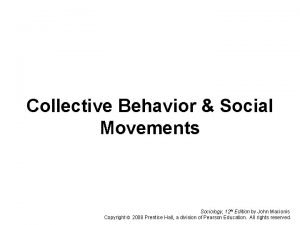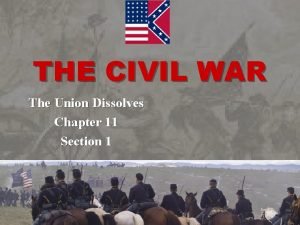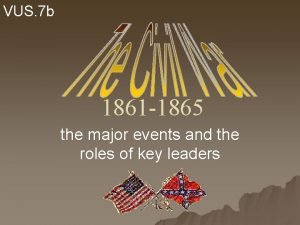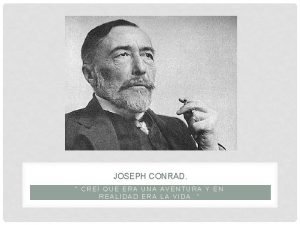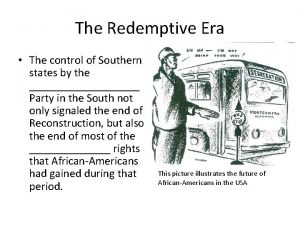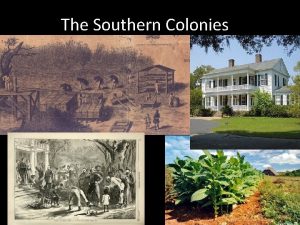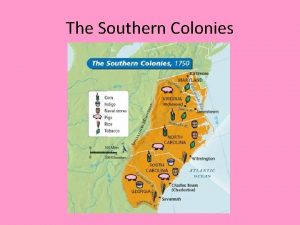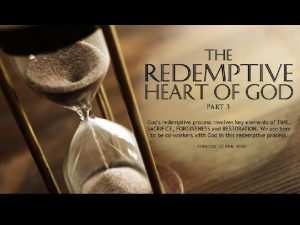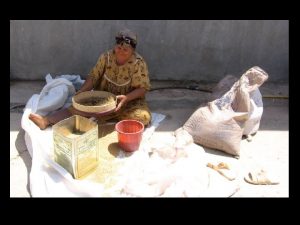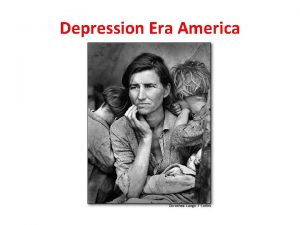The Redemptive Era The control of Southern states
























- Slides: 24

The Redemptive Era • The control of Southern states by the __________ Party in the South not only signaled the end of Reconstruction, but also the end of most of the _______ rights that African-Americans had gained during that period. This picture illustrates the future of African-Americans in the USA

The Bourbon Triumvirate Time span: • • 1870 s-1890 s • Democrats Goal: • reclaim the state from scalawags & ____________ • Make Georgia self-sufficient • Lower _______ • Diversify Georgia’s economy • Help with economic improvements… but they largely _________ the needs of poor whites and blacks

The Bourbon Triumvirate Joseph E. Brown Governor: 1857 promoted states’ rights and supported radical reconstruction Alfred Holt Colquitt Governor: 1876 Reduced state debt; new state constitution 1877 John B Gordon Governor: 1886 Reduced state debt; brought new industry to state

Decline of the Bourbon Triumvirate • “Independent Democrats” criticized the Bourbons for not attending to the needs of the ________ or improve education and _____________ conditions in factories. • Leaders William and Rebecca __________ worked to improve conditions for poor Georgians using newspapers to highlight problems in the state. • The convict lease system “__________” prisoners to companies to use as workers. It took many years for the poor conditions the prisoners endured to be brought to light and changed.

The Feltons • William Felton – – – __________ Farmer Methodist Preacher ________ Speaker Independent Democrats • Rebecca Latimer Felton – Supported her husband’s political causes – His Campaign leader – Independent Democrats

The Feltons • Used their newspaper, The __________ to attack the Bourbons • Wanted to help… – _________ – Lower middle class – HATED the Convict Lease System They pushed for improvements in: - education - Prison reform - Limits on ________ - They planted the roots of what would become the Populist Party.

Rebecca Latimer Felton • Leader in the… • Suffrage Movement: – Working to get women the right to vote – The _________ Amendment granted ___________ the right to vote (1920) • Temperance Movement: – Anti-Alcohol Movement – The __________ Amendment banned the sale and manufacture of ____________

The Convict Lease System – _________ were leased (hired out) to people who provided them with housing and food in exchange for _____ – Housing was usually substandard; food not healthful and in meager amounts – Prisoners were treated very poorly and often denied _____ necessities

The Convict Lease System How did this happen? • Several key factors: – Cheap labor was necessary to __________ and then allow Southern agriculture to flourish – Many whites wanted to maintain the ____________ of their race over blacks – Whites dominated all facets of power in the South and few whites chose to even try and challenge this ‘system’ Why did this happen? • Arresting able-bodied blacks meant – Immediate financial gain for the sheriff and local _______ – Longer term revenue for county/state • Met need for cheap labor which allowed economy to grow • Met social desire to keep whites _________

Practical Example • John Davis, African American, arrested in Goodwater Georgia, 1901 • Arrested by Robert Franklin, constable and owner of a dry-goods store • Accused of owing $40 to Franklin • $35 in fines added for a total of $75 • Wealthy land owner pays the $75 and ‘contracts’ Davis to work for 10 months. (p. 129 -132)

Financial Incentives Cost to the companies: • $6 per month per man (Tennessee Coal, Iron and Railroad, 1903) • Pay to a free laborer ($ 1 -3 per day) • No cost or fine if a convict died while in custody of the company • Bogus charges often added and paperwork simply lost • State income for could equate to 10% of total revenues Additional costs tacked on: • . 50 for sheriff to deliver a warrant • $1 for making an arrest • . 35 for the clerk who certified court documents • . 60 cent fees for judge and sheriff • . 50 cents for each white witness

How did it work? • Companies would __________ with individual sheriffs or even with the state • Companies provided: – “prisons” – lock up space – Guards – who could chain, beat, shoot and torture – Clothing – _______ – Medical care

The New South * Term given to the South because it showed a new economic growth and prosperity after the Reconstruction and Redemption periods. *

Henry ________ • Editor of the Atlanta Constitution newspaper from 1880 -1889 • Urged Georgians to forget the past and create a “________ SOUTH” • He supported a new line of thinking between the “old South” which “rested everything on slavery and agriculture, unconscious that these could neither give nor maintain healthy growth, ” and a “new south” – thrilling with the consciousness of growing power and prosperity

Economic Plan of the New South He urged GA to: • Develop _____ within the state • Promoted industrializing and modernizing the ________. • In response, the North began to ______ in Georgia In the late 1800 s, northerners invested in southern textile mills. Women provided much of the cheap labor.

Other notable Grady improvements: • Grady pushed for social equality • Grady promoted the creation in Atlanta of the Georgia Institute of _________, a state vocationaleducation school.

Henry Grady’s Most Famous Speech • "Once I attended an unusually sad funeral in Pickens County…. They buried him in the midst of a marble quarry. They cut through solid marble to make his grave, and yet the little headstone they put above him came from Vermont. They buried him in the heart of a pine forest and yet the rude pine coffin was imported from Cincinnati. They buried him within touch of an iron mine, and yet the nails in the coffin and the shovel they used was imported from Pittsburgh. They buried him by the side of the best sheepgrazing country on earth, and yet the wool inside the coffin and the wool bands they used in lowering his body were brought from the North. The South furnished nothing for that funeral but the hole in the ground and the corpse. “ • Let’s look at this one! – What resources did the South possess according to the paragraph? – What resources did the South import for the funeral? – Why is this ironic?

The International Cotton Exposition • _______ • One of the principle planners was Henry Grady. • __________ hosted the International Cotton Exposition to show off the South’s new industries • They spotlighted attention on GA’s cotton _________ industry! Business grew up long the railroads which provided transportation for raw materials and finished goods.

The International Cotton Exposition • Equipment for making textiles was _______ • Southern agricultural products were shown – Ex) Sugar, rice & tobacco • New ________ were created & millions of dollars were invested in Atlanta • Atlanta became the “_________ hub” of the New South Why would a phoenix be a cool symbol of the International Cotton Exposition?

The Populist Party • Populism: political idea that supported the rights of the “common” people in their struggle with the wealthy people • Poor farmers and low wage workers were followers of the Populist Party • Tom Watson, famous Georgia Populist, worked for the passage of the Rural Free Delivery bill so that mail would be delivered to rural areas for free

The Populist Party in GA • Who was in charge? • Tom __________: – Lawyer – Focused on GA’s ______ and struggling farmers – He passed the ___________________ Delivery Bill – Elected to the GA General Assembly – Elected to the US Congress by Georgia – Concerned about poor African. American farmers – Wanted the races to work ________ to help farmers

The Populist Party & Rural Free Delivery • This Bill promised free mail delivery to _________ farmers (1893) • How might this change people’s lives? – _______ in the Post office – Increased speed of mail delivery – MOST IMPORTANT: the construction of new ______ and bridges

Neill Primary Act The Neill Primary Act Smaller counties had more county unit “votes” even though they had fewer voters …People could be elected to office without getting a majority of votes Allowed smaller, less populated white dominated counties in Georgia to have greater power and influence in the General Assembly than the larger, more populated counties Went against proportional representation Declared unconstitutional in 1962 Created the County Unit System Top 8 counties - 6 unit votes = 40 total votes Middle 30 counties – 4 unit votes = 120 total votes Small 121 counties – 2 units = 242 total votes

Atlanta Race Riots 1906 • Successful African Americans were taking jobs from whites • Feeling threatened, white mobs attacked black businesses and individuals in Atlanta • At least 25 people were ________ in the riots • Led to the rise of the National Association for the Advancement of Colored People (________)
 Is virginia a northern or southern state
Is virginia a northern or southern state Redemptive social movements
Redemptive social movements Redemptive social movement
Redemptive social movement Redemptive social movement
Redemptive social movement Alternative social movement
Alternative social movement Redemptive social movement
Redemptive social movement Southern states civil war
Southern states civil war Vus 7a what event sparked secession of the southern states?
Vus 7a what event sparked secession of the southern states? Quiz 2 the baroque era
Quiz 2 the baroque era Elizabethan era vs victorian era
Elizabethan era vs victorian era Creí que era una aventura y en realidad era la vida
Creí que era una aventura y en realidad era la vida Poema sobre as estrelas
Poema sobre as estrelas Slave states free states
Slave states free states Big states vs small states guard against tyranny
Big states vs small states guard against tyranny Victorian era condoms
Victorian era condoms Hát kết hợp bộ gõ cơ thể
Hát kết hợp bộ gõ cơ thể Bổ thể
Bổ thể Tỉ lệ cơ thể trẻ em
Tỉ lệ cơ thể trẻ em Voi kéo gỗ như thế nào
Voi kéo gỗ như thế nào Thang điểm glasgow
Thang điểm glasgow Hát lên người ơi
Hát lên người ơi Môn thể thao bắt đầu bằng từ đua
Môn thể thao bắt đầu bằng từ đua Thế nào là hệ số cao nhất
Thế nào là hệ số cao nhất Các châu lục và đại dương trên thế giới
Các châu lục và đại dương trên thế giới



